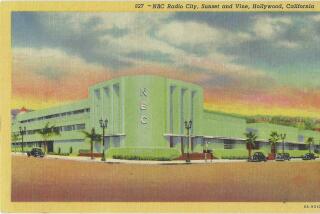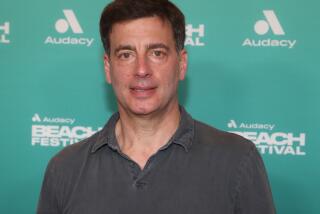KRTH puts a new spin on oldies
- Share via
While many 35-year-olds have settled on their favorite tunes, playing those chestnuts over and over, wary of anything new, “K-Earth 101” -- the oldies station born in 1972 -- decided it can’t afford to be so rigid.
Instead, the station has been stamping ‘70s soft-rock and even some disco hits as oldies while trying to attract new listeners in this, its 35th year -- making it not just an oldie but positively ancient by the standards of a capricious radio industry.
“Stations don’t typically stay in a format that long,” said program director Jhani Kaye. “The reason people enjoy this format, and K-Earth in particular, is it is a Top 40 radio station. We’re just not playing newly released music.”
The station is celebrating its anniversary with a concert Saturday at the Verizon Wireless Amphitheatre, with Chicago, the Doobie Brothers, the Stylistics and War -- bands that were just hitting the charts when KRTH-FM (101.1) debuted but whose songs are now staples on the oldies playlist -- and the Four Tops, whose Motown sound has been integral to the station since its beginning.
“The songs that we play, they’re like diamonds, man. They last forever,” said “Shotgun” Tom Kelly, KRTH’s afternoon drive-time DJ, who has been at the station a decade. “K-Earth has always been a fun environment. It’s like the Disneyland of radio -- the songs are classic, they’ve always been there, and they’ll always be there. And people really dig it.
“Look at ‘American Idol.’ They have their contestants do a lot of our music.”
For several years, the station had been focused on music mainly from the 1960s -- Aretha Franklin, Elvis Presley, the Beatles, et al. But when Kaye arrived last year, after two decades at adult-contemporary outlets KOST-FM (103.5) and KBIG-FM (104.3), he started adding more songs from the 1970s and even beyond in some cases. Now, listeners can hear Ritchie Valens’ “La Bamba” from 1958 next to the 1976 disco hit “Heaven Must Be Missing an Angel” by Tavares, followed by the Supremes’ “Love Child” from 1968.
“We’ve created a feature called ‘today’s oldies,’ ” Kaye said, which includes a sprinkling of artists such as Phil Collins, Fleetwood Mac and Earth, Wind & Fire. Even a song from 1999, Santana’s “Smooth,” can work in that context, he said, because the band’s earlier work is also featured on the station and the sound of the newer song meshes with others being played.
“The audience tells us when it’s acceptable to add new music to the playlist. They get to vote a song on or off the air,” in surveys the station conducts at least three times a year, Kaye said.
Earlier, when the station was locked into the ‘60s, it was essentially following one group of listeners, playing their favorite music as they aged. Now the station is adding newer songs, targeting a specific demographic, such as 25 to 54, or 35 to 64, and capturing the ears of new listeners as they pass through that window.
“It makes it sound younger, although it doesn’t turn off the original baby boomers,” said Pat Duffy, KRTH’s former general manager, who was at the station from 1991 to 2004. After all, he said, “today’s music is going to be somebody’s oldie.”
But the backbone of the playlist remains the same -- the Beach Boys, the Byrds, Marvin Gaye and others.
Lonnie Jordan, lead singer of War, said he’s grateful KRTH provides a venue for mature bands to reach their old fans and new listeners.
“The younger generation, who don’t remember ‘back in the day,’ they get a chance to relive history,” said Jordan, who likened the experience to his own childhood in Compton, listening to his mother’s Billie Holiday and Ray Charles records.
“Every day you hear K-Earth is like another chapter in history. It’s a learning station. It’s no different for me from PBS,” he said.
The station was Top 5 in the Los Angeles-area ratings in 1997, slipped to 15th as recently as summer 2006, but has begun to creep back up the chart. In the spring 2007 ratings, the latest available, it placed 12th among all listeners, with a 3.1% share of the audience -- down slightly from the previous quarter but higher than the same period in 2006. Among adults 25 to 54, the station placed sixth among English-language stations. In the winter, it placed first among all stations in the market among listeners 35 to 64.
KRTH started life as KHJ-FM, merely the shadow of its sister, KHJ-AM (930), the phenomenally popular “Boss Radio” station of the mid- to late ‘60s. It featured a Top 30 playlist -- Top 40 apparently being too discursive -- and larger-than-life DJs such as Robert W. Morgan and the Real Don Steele. Though music still ruled on AM, the higher-fidelity FM band was drawing new listeners, and the FCC decreed that station owners could no longer simply simulcast their AM programming on their FM stations.
On the weekends, KHJ-AM loosened its tight playlist a bit to include “monster oldies,” which always drew raves from listeners. “So we knew the power of it. It just seemed a way to go,” said Bill Drake, the architect of the “Boss Radio” format with his programming partner, Gene Chenault. So they let loose the oldies on KHJ-FM.
But the station became so popular, it began to cannibalize listeners from its AM sibling, Drake said. They renamed the FM station to differentiate it, and K-Earth was born.
The change came at 5:30 a.m. on Oct. 16, 1972, when KHJ-FM became KRTH-FM, and, according to an article from then in The Times, “ ‘Solid Gold’ radio became ‘Nostalgia Radio,’ playing all the songs that were hits between 1953-1963.”
“The KRTH format bears watching,” wrote reporter Don Page.
Strange as it may seem now, the oldies format was a novelty at the time. No one knew how long it would last. But Brian Beirne, known as “Mr. Rock ‘n’ Roll,” a DJ at the station until 2004, was optimistic when he arrived in 1976.
“I had a good feeling about what we were doing, and you can’t go wrong playing the hits,” he said. “Long after we’re gone, people will be digging out a Chuck Berry or an Elvis song. Ninety-five percent of the rest of it, people will never remember.”
More to Read
The biggest entertainment stories
Get our big stories about Hollywood, film, television, music, arts, culture and more right in your inbox as soon as they publish.
You may occasionally receive promotional content from the Los Angeles Times.










